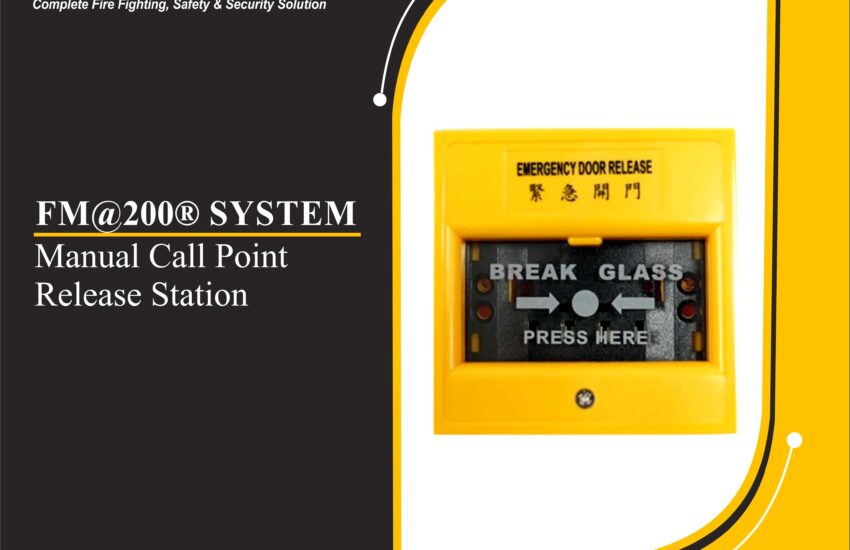Manual Call Point Release Station, also known as a fire alarm break glass unit, is a manual fire suppression activation device that allows individuals to manually trigger a fire alarm or fire suppression system in case of a fire emergency. Typically installed near exits or in high-risk areas, this device provides a reliable backup in case automatic detection systems fail or are delayed.
It is an integral part of FM-200 fire suppression systems, clean agent systems, and automatic fire alarm systems in commercial buildings, data centers, factories, and hazardous environments.
Key Features of Manual Call Point Release Station
🔴 Break Glass Operation
- Equipped with a breakable glass or resettable element that activates the alarm/suppression system when pressed.
✅ Manual Override for Suppression Systems
- Allows manual discharge of fire suppression agents like FM-200, NOVEC 1230, or CO₂ in emergencies.
🔄 Resettable or Replaceable Glass
- Some models come with resettable plastic elements for repeated use without replacing parts.
- Others use traditional glass elements for single-use operation.
⚙️ Durable and Fire-Resistant Construction
- Built from high-impact plastic or metal to resist damage in harsh environments.
- Flame retardant and compliant with fire safety regulations.
🔌 LED Indicator and Status Feedback
- Some advanced units feature LED indicators to show activation or system status.
Applications of Manual Call Point Release Stations
- FM-200 fire suppression systems
- CO₂ and clean agent systems
- Data centers and server rooms
- Telecommunication facilities
- Industrial manufacturing plants
- Commercial buildings and high-rise offices
- Warehouses and storage areas
Manual release stations are typically mounted near emergency exits, equipment rooms, or access control points for quick and easy activation.
How Manual Call Point Release Stations Work
- Emergency Detected: In the event of a fire or system failure, the user activates the MCP by pressing or breaking the glass.
- Signal Transmission: The MCP sends a signal to the fire alarm control panel or suppression control panel.
- System Activation: The connected system either triggers an alarm, alerts fire safety personnel, or activates gas suppression release based on the configuration.
🔒 Safety Note: These stations should only be used by authorized personnel or during real emergencies.
Installation Guidelines
- Must be installed at accessible height (typically 1.2 to 1.4 meters) above floor level.
- Place near emergency exits, room entrances, or critical equipment zones.
- Should be clearly labeled and accompanied by instruction signage.
- Must be connected to fire alarm or suppression control panel using approved cabling.
Technical Specifications (Typical)
| Specification | Details |
|---|---|
| Device Type | Manual Call Point / Manual Release Station |
| Operation | Break glass or press-type activation |
| Material | Flame-retardant plastic or metal |
| Mounting Type | Surface or flush mounted |
| Electrical Rating | 24V DC (typical), compatible with fire systems |
| Reset Mechanism | Key resettable or replaceable glass |
| Compliance Standards | EN 54-11, UL Listed, CE Marked, ISO Certified |
| Color | Red (standard for fire systems) |
| Indicator | Optional LED activation indicator |
Benefits of Manual Call Point Release Stations
- ✅ Quick manual activation of fire suppression system
- ✅ Simple and intuitive to use
- ✅ Reliable backup to automatic fire detection
- ✅ Increases safety in high-risk areas
- ✅ Reduces response time during fire emergencies
- ✅ Compatible with various suppression systems
Compliance and Certifications
Ensure your Manual Call Point meets the following standards:
- EN 54-11 – European standard for manual fire alarm call points
- UL Listed – Underwriters Laboratories certified for fire safety
- NFPA Compliant – In line with NFPA 72 and NFPA 2001
- TCVN Certification – Compliance with Vietnamese fire standards
Conclusion
A Manual Call Point Release Station is a critical safety component in any fire alarm or gas suppression system, enabling fast manual intervention during emergencies. Whether installed in a data center, server room, factory, or commercial building, these devices offer an added layer of fire protection that can make a difference in saving lives and property.


